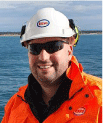Analysis of an existing hydrocarbon gas pipeline for conversion to dense phase CO2 service
David Levy A *A

David Levy has 15 years’ experience in the oil and gas industry and is currently the Senior Integrity Engineer with Esso Australia. He previously held the role of Senior Subsea, Pipeline & Riser Engineer with Esso Australia, and is a pipeline subject matter expert for the affiliates offshore and onshore pipeline network and Low Carbon Solutions business. He holds bachelor’s degrees in mechanical engineering/aerospace technology from Monash University and an MBA from Australian Institute of Business. He is Chartered with Engineers Australia and holds AMPP/NACE CP2 Certification. |
Abstract
Esso Australia is investigating the feasibility of a carbon capture and storage (CCS) project in East Gippsland, Victoria. Known as the South-East Australia Carbon Capture and Storage (SEA CCS) Hub, the project aims to re-purpose existing infrastructure and offshore depleted hydrocarbon reservoirs to store carbon dioxide (CO2). The project aims to reduce greenhouse gas emissions from Esso’s Longford Gas Conditioning Plant, and to unlock future CCS opportunities for Australia. One option identified as part of the SEA CCS feasibility was to convert part of the existing onshore section of the Barracouta 450 mm gas pipeline to Longford Gas Plant (BTA450-LFD), Licence PL/1 under the Victorian Pipeline Act, to dense phase CO2 service. This paper documents the initial findings of the potential for the onshore section of the BTA450 for conversion, with particular emphasis on brittle and ductile fracture control considerations. In summary, when attempting to convert existing hydrocarbon gas pipelines for CO2 service, operators need to undertake an appropriate assessment of fracture control considerations. The insights of this paper may serve as a useful guide document for assessing other existing onshore pipelines for CO2 service conversion. Due to the thermal modulation effect of the surrounding water for subsea pipelines, this guidance does not apply to subsea pipeline sections.
Keywords: AS 2885, brittle fracture, carbon capture, CCUS, CO2, DNV-RP-F104, ductile fracture, emissions reduction, fracture control, Gippsland, Gippsland Basin, low carbon solutions, pipelines.
 David Levy has 15 years’ experience in the oil and gas industry and is currently the Senior Integrity Engineer with Esso Australia. He previously held the role of Senior Subsea, Pipeline & Riser Engineer with Esso Australia, and is a pipeline subject matter expert for the affiliates offshore and onshore pipeline network and Low Carbon Solutions business. He holds bachelor’s degrees in mechanical engineering/aerospace technology from Monash University and an MBA from Australian Institute of Business. He is Chartered with Engineers Australia and holds AMPP/NACE CP2 Certification. |


